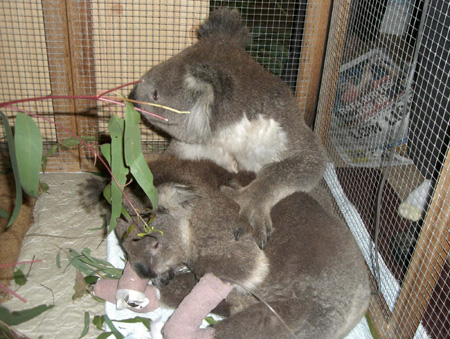CANBERRA -- A bewildered and badly burnt koala has emerged from the ashes of Australia's deadliest bushfires, a small beacon of hope after days of devastation and the loss of more than 180 lives.
|

A koala named Bob (top), rescued from last week's deadly bushfires, puts his paw around new friend and fellow fire survivor Sam as she recovers from her burns at a wildlife centre near Melbourne February 11, 2009. A love story about two koalas rescued from Australia's deadliest bushfires has provided a glimmer of hope after days of devastation and the loss of more than 180 lives. [Agencies]
|
Volunteer firefighter Dave Tree came across the stricken koala, affectionately named Sam, cowering in a burnt out section of a forest at Mirboo North, some 150 km (90 miles) southeast of Melbourne.
As a colleague filmed him, he approached the koala and offered the terrified animal some water, gently talking until the koala put a paw on his hand and began drinking from the plastic water bottle.
"Things do survive the bushfire. There's a koala here. You alright buddy?" said Tree in the video which was posted on the video sharing website YouTube (www.youtube.com/watch?v=-XSPx7S4jr4).
"This guy has survived. He's looking pretty bewildered."
The koala, who turned out to be female, was taken to the Southern Ash Wildlife Shelter in Rawson while photos of Australia's beloved marsupial, taken on a mobile phone, spread quickly across the globe.
Carer Jenny Shaw told reporters that Sam had suffered burns on her paws and was in pain but on the road to recovery.
The story was reminiscent of another koala named Lucky who survived the bushfires that destroyed about 500 homes with the loss of four lives in the capital of Canberra in 2003.
Lucky became a symbol of hope as people rebuilt lives after the fires and was cared for in a nature reserve, dying recently.
As the fires subside, animals of all shapes and sizes who survived the fires have started to emerge from the charred bushland.
The Australian Wildlife Health Centre at the Healesville Sanctuary, located an hour's drive from Melbourne, has been taking in increasing numbers of injured animals.
But director John Gibbons said so many of the animals were so badly injured that they had to be put down.
"We had a joey today, an eastern grey of about 8 to 10 months old, but we could not save it," he said.
"We expect the workload to increase in coming days as the fires abate and roadblocks are lifted."
Wildlife workers said they had several weeks of hard work in front of them to save as many animals as possible.
Anne Fowler, spokeswoman for the Australian Veterinary Association, said wildlife likely to be affected include koalas, ringtail possums, kangaroos, reptiles and echidna.
"For those animals that can be treated, we treat the wounds under anaesthesia then protect them until they start to heal," she said. "This can take from two weeks to greater than four weeks depending on the severity of the burn."

